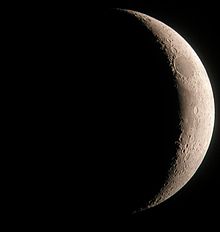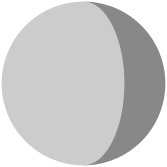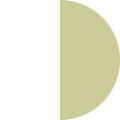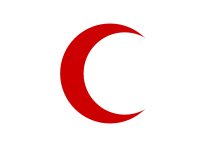Crescent
![]()
This article describes the use of the crescent moon as a symbol; for its astronomical significance, see Moon phase.
![]()
This article or subsequent section is not sufficiently supported by evidence (e.g., anecdotal evidence). Information without sufficient evidence may be removed in the near future. Please help Wikipedia by researching the information and adding good supporting evidence.
The symbol of the crescent moon, also known as the sickle moon or quarter moon, is usually represented figuratively as a shape that results when a portion of one circular surface is removed by a second circular surface. The two-sided curved concave-convex figure with two peaks formed in this way is named after the earth's moon and the cutting tool crescent. The symbol stylized represents the moon in the first or last quarter of the lunar phases. The crescent moon does not show a crescent moon in the astronomical sense, as this denotes the phase of dichotomy when the moon is just half illuminated and appears as a semicircle. Nevertheless, the crescent moon symbol is also referred to as a half moon in colloquial language or by the International Red Cross and Red Crescent Movement.
.jpg)
Moon shuttle in the night sky

Actual crescent moon for comparison

Common stylized representation of the crescent moon
Geometric consideration
Stylized representations of the crescent moon are very often in the form of a differential surface of two overlapping circular surfaces. There are various possibilities here. The radius of the "subtracted" circle can be larger, equal or smaller than the radius of the circle from which the subtraction is made, and the centres of the two circles can be at different distances.
The shape of the real crescent moon visible in the sky is geometrically different. The sun always illuminates exactly one half (hemisphere) of the lunar sphere and the day-night boundary is thus in principle a great circle whose circumference and diameter correspond to the circumference and diameter of the moon or the lunar disk. Except at new and full moon, the image of this great circle as seen from Earth is distorted in perspective to an ellipse, half of which is visible as a terminator on the Earth-facing side of the Moon. The long axis of this ellipse corresponds to the diameter of the lunar disk, while the short semi-axis is variable and depends on the phase of the moon. At crescent moon its length is zero and the ellipse becomes a line. Thus the real lunar crescent is always bounded outward by the circular arc of the lunar disk, but inward by the apparent elliptical arc of the terminator. Therefore the real crescent moon has no overlapping peaks, as they are often found in stylized representations.
· Difference of circular areas
· 
· 
· 
· 
· Real moon phases
· 
Crescent moon astronomical
· 
Crescent astronomical
In astronomical parlance, the crescent moon, where exactly half of the illuminated lunar surface is visible and appears as a semicircular area of the lunar disk, is also referred to as a half phase (or dichotomy) and thus marks the end of the first quarter as a waxing crescent moon and the beginning of the last quarter of a lunar cycle as a waning crescent moon.
A recumbent crescent moon - as it is more often seen in regions near the equator - is also called a lunar aisle.
Occurrence and meanings
The symbol of the crescent moon has been seen on flags and coats of arms for centuries, sometimes with a face added, see Moon (heraldry).
As an astronomical symbol, the crescent moon represents the waxing (☽ - Unicode U+263D, ![]() ) or waning moon (☾ - Unicode U+263E,
) or waning moon (☾ - Unicode U+263E, ![]() ) or a lunar eclipse. Also, the same character can be used to symbolize a solar eclipse. The crescent of the waning moon also represents the moon as a celestial body.
) or a lunar eclipse. Also, the same character can be used to symbolize a solar eclipse. The crescent of the waning moon also represents the moon as a celestial body.
In astrology, the crescent of the waning moon stands for the moon as a "planet". The crescent of the waxing moon stands for Monday and, as in alchemy, as an element symbol for the planetary metal silver. Furthermore, in astrology the little moon ship (![]() ) is the symbol for the rising moon. The falling moon is correspondingly symbolized by a standing crescent moon (
) is the symbol for the rising moon. The falling moon is correspondingly symbolized by a standing crescent moon (![]() ). The Lilith symbol (
). The Lilith symbol (![]() ) in astrology stands for the planet Lilith, the Black Moon or the Dark Twin of the Moon. However, this is not a celestial body, but either the apogee or the second ("empty") focal point of the eccentric-elliptical lunar orbit.
) in astrology stands for the planet Lilith, the Black Moon or the Dark Twin of the Moon. However, this is not a celestial body, but either the apogee or the second ("empty") focal point of the eccentric-elliptical lunar orbit.
The crescent moon is a significant, if not the most significant, symbol in Islam. As such, it is often combined with a (often five-pointed) star. The star is usually smaller than the crescent and is usually located in or in front of the opening of the crescent (see below).
The crescent moon appears on coins of the Electorate of Saxony as the mintmaster's mark of Gerhard Stein of the Leipzig mint (around 1512) and of Hans Passek of the Zwickau mint (1477-1478).
The crescent moon, open on the right and equipped with a nose, stands - in reference to the alchemical symbol - for silver in the German imperial stamp on silverware.
Besides this, quite different terms refer to a - here called "half-moon" - crescent-like shape, e.g.
- Red Crescent: a sign of protection under the Geneva Conventions and a symbol of the International Red Cross and Red Crescent Movement. The corresponding national societies of almost all Muslim countries use the Red Crescent as their symbol and name.
- Fertile Crescent, a high-precipitation winter rainfall area north of the Syrian Desert or in the north of the Arabian Peninsula.
- Golden Crescent, the main opium growing area in Asia.
Also, various baked goods have a three-dimensional shape whose cut can resemble a crescent moon, including the croissant, the Kipfel and the Kipferl. This is also referred to as a "croissant shape", as the tips are reminiscent of animal horns.

Symbol of the Red Crescent
Questions and Answers
Q: What is a crescent?
A: A crescent is a shape produced when a circular disk has a segment of another circle removed from its edge.
Q: How is a crescent shape formed?
A: A crescent shape is formed when a circular disk has a segment of another circle removed from its edge.
Q: How is a crescent shape enclosed?
A: A crescent shape is enclosed by two circular arcs of different diameters which intersect at two points.
Q: Does the enclosed shape include the center of the original circle?
A: The enclosed shape usually does not include the center of the original circle.
Q: What was the crescent used as a symbol for in Byzantium?
A: The crescent was long used as the symbol of Byzantium.
Q: What is the main symbol for the religion Islam?
A: The main symbol for the religion Islam is now the crescent.
Q: What is the significance of the crescent in Islamic symbolism?
A: The crescent symbolizes the beginning of each lunar month, which is significant to the Islamic calendar.
Search within the encyclopedia